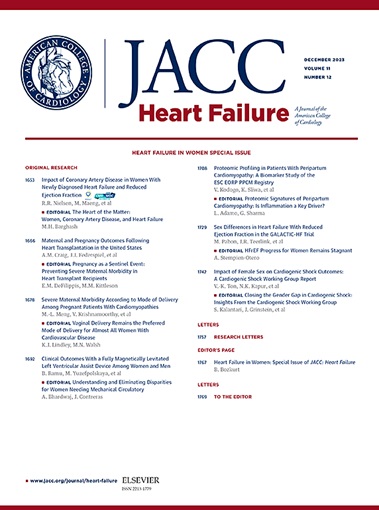急性心力衰竭住院患者的临床表现、生物标志物轨迹和结局
IF 11.8
1区 医学
Q1 CARDIAC & CARDIOVASCULAR SYSTEMS
引用次数: 0
摘要
先前的研究已经表明心力衰竭(HF)的男女之间存在重要但有时异质性的差异。本研究旨在探讨当代大型急性心力衰竭(AHF)队列中男性和女性的表型和病程的性别差异。方法作者分析了6545例AHF患者(40%为女性),这些患者参加了RELAX-AHF-2(在AHF标准治疗中加入舍来拉辛的疗效、安全性和耐受性)。结果女性年龄较大(78岁vs 72岁;P < 0.001),射血分数较高(45% vs 35%; P < 0.001)。在住院期间,女性接受较低的利尿剂量(第5天静脉注射呋塞米当量:200 vs 240 mg; P < 0.001),体重减轻较低(相对;P = 0.026),利尿反应稍低(第5天- 0.33 vs - 0.36 kg/40 mg呋塞米;P = 0.011),与男性相比,第5天类似的体征和症状改善(均校正P >; 0.05)。更多的女性在第5天出现肾功能恶化(WRF;调整后HR: 1.24 [95% CI: 1.06-1.46]; P = 0.009)。与没有WRF的男性和女性相比,经历WRF的女性180天心血管死亡和因心衰或肾功能衰竭(RF)再住院的风险增加,以及因HF/RF再住院的风险增加(调整了相互作用的P值:P <; 0.001)。女性和男性的其他结局发生率相似(均P >; 0.2)。结论:在AHF住院期间,尽管症状缓解和出院后结果相似,但与男性相比,女性接受了较低剂量的环状利尿剂,体重减轻较少,利尿反应略低。早期发生的WRF在女性中更为常见,并且与180天的不良预后相关。舒拉辛加入AHF标准治疗的疗效、安全性和耐受性[RELAX-AHF-2]; NCT01870778)本文章由计算机程序翻译,如有差异,请以英文原文为准。
Clinical Presentation, Biomarker Trajectories, and Outcomes in Women and Men Hospitalized for Acute Heart Failure
Background
Previous studies have shown important but sometimes heterogeneous differences between women and men with heart failure (HF).
Objectives
This study aims to investigate sex differences in the phenotype and journey of men and women in a large contemporary acute heart failure (AHF) cohort.
Methods
The authors analyzed 6,545 AHF patients (40% women) enrolled in RELAX-AHF-2 (Efficacy, Safety and Tolerability of Serelaxin When Added to Standard Therapy in AHF).
Results
Women were older (78 vs 72 years; P < 0.001) and had higher ejection fraction (45% vs 35%; P < 0.001). During hospitalization, women received lower diuretic doses (furosemide equivalent through day 5: 200 vs 240 mg intravenous; P < 0.001) and achieved lower weight loss (relative; P = 0.026), with slightly lower diuretic response (−0.33 vs −0.36 kg/40 mg furosemide at day 5; P = 0.011) and similar sign and symptom improvement by day 5 compared with men (all adjusted P > 0.05). More women experienced worsening renal function by day 5 (WRF; adjusted HR: 1.24 [95% CI: 1.06-1.46]; P = 0.009). Women experiencing WRF had increased risk of 180-day cardiovascular death and rehospitalizations for HF or renal failure (RF) and of rehospitalizations for HF/RF compared with men and women without WRF (adjusted P for interaction: P < 0.001). Incidence of other outcomes was similar in women and men (all P > 0.2).
Conclusions
During an AHF hospitalization, women received lower doses of loop diuretic agents and achieved less weight loss with slightly lower diuretic response compared with men, despite similar symptom relief and postdischarge outcomes. Early incident WRF was more frequent in women and was associated with worse 180-day outcomes. (Efficacy, Safety and Tolerability of Serelaxin When Added to Standard Therapy in AHF [RELAX-AHF-2]; NCT01870778)
求助全文
通过发布文献求助,成功后即可免费获取论文全文。
去求助
来源期刊

JACC. Heart failure
CARDIAC & CARDIOVASCULAR SYSTEMS-
CiteScore
21.20
自引率
2.30%
发文量
164
期刊介绍:
JACC: Heart Failure publishes crucial findings on the pathophysiology, diagnosis, treatment, and care of heart failure patients. The goal is to enhance understanding through timely scientific communication on disease, clinical trials, outcomes, and therapeutic advances. The Journal fosters interdisciplinary connections with neuroscience, pulmonary medicine, nephrology, electrophysiology, and surgery related to heart failure. It also covers articles on pharmacogenetics, biomarkers, and metabolomics.
 求助内容:
求助内容: 应助结果提醒方式:
应助结果提醒方式:


